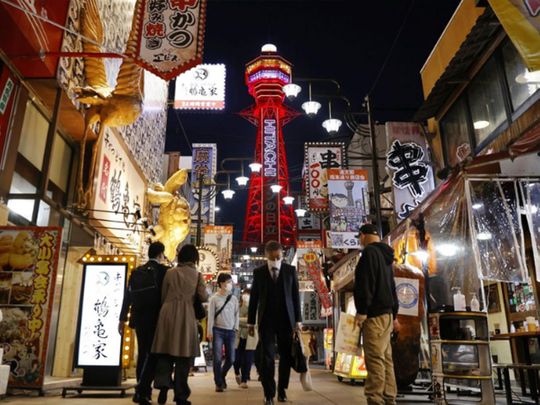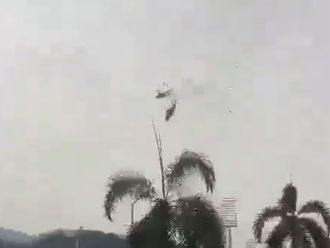
Tokyo: Alarmed by increasing security threats and the risk of war in the Indo-Pacific, Japan will seek to purchase hundreds of US-built Tomahawk cruise missiles as part of a major defence build-up unprecedented in the postwar period, Japanese and US officials said.
The missile buy would boost Japan’s long-range strike capability and mark a stunning break with a long tradition of eschewing offensive weapons. And it would enhance Japan’s conventional deterrent as China undertakes a sweeping military modernisation and North Korea barrels ahead with its nuclear program.
Japan will move forward on the Tomahawk decision as a part of the roll-out of its new national security and defence strategies this month, along with a major hike in Japan’s defence budget — to the Nato benchmark of 2 per cent of gross domestic product, which would make it the third-largest in the world. Together, these steps signal a Japan moving to shed its longtime pacifist constraints.
“Japan wanted to limit its defence spending and try not to acquire second-strike capability. But the situation surrounding us does not permit us to do that,” said Ichiro Fujisaki, former Japanese ambassador to the United States. “Many people thought [war] was a 20th-century issue, but we are now seeing that again.”
The missile acquisition and the growing defence budget have the support of the Biden administration, which views Japan as a pivotal partner in the western Pacific. Officials see a deepening alliance with Japan as part of a broader strategy of regional cooperation to enhance security, including a deal involving the United States and Britain helping Australia develop nuclear-powered submarines, and the United States lifting limits on South Korea building ballistic missiles.
“The United States is not just taking unilateral steps, but is seeking to empower allies and partners in ways that are deeply significant and magnify our capacities in the region,” said a US official who, like several others interviewed, spoke on the condition of anonymity to discuss plans that are not yet public.
The decision to buy hundreds of Tomahawks — 400 to 500 by some accounts — will put China and North Korea on notice that Japan is serious about self-defence, and that the bilateral alliance — arguably the most significant militarily in the region — is growing stronger in the face of threats from Beijing and Pyongyang, officials said.
“The introduction of this system will symbolise a major positive change regarding counterstrike capabilities,” a Japanese official said. The Tomahawk missiles, with a 1,000-mile-plus range, would put military targets on mainland China within reach.
While Japan has gradually been shifting away from self-defence-oriented policies — a 2014 reinterpretation of its constitution allowed for military action in the event an ally was attacked — change had been incremental.
Until now.
Russia’s February attack of Ukraine was “absolutely” a pivotal factor in creating the political climate that allowed the ruling Liberal Democratic Party to push a strong national security agenda over anti-militarist public sentiment, a second Japanese official said.
Polls show that post-Ukraine, public support for what the Japanese government calls “counterstrike” capability has clearly risen, from 37 per cent in July 2020 to over 60 per cent in June.
For the Japanese, the war in Ukraine has made a Chinese attack of Taiwan appear much more possible, deepening the public’s concern over Japan’s military readiness in the event of a regional conflict.
Prime Minister Fumio Kishida has pushed a more assertive foreign policy agenda since February. Late last month, he took the extraordinary step of saying he wanted to grow the defence budget to 2 per cent of GDP by 2027 — a move long considered controversial and implausible. If he succeeds, Japan in five years likely would have the world’s third-largest defence budget after the United States and China.
Japan views the Tomahawk missiles as a “stopgap” weapon that could be delivered within five or so years, as it works to extend the range of its own Type 12 cruise missiles to have a similar ability to attack military targets on land from a distance. But that project is likely to be a 10-year effort, experts said.
Japan plans to reconfigure existing vertical launch systems on its destroyers to accommodate the Tomahawks, officials said. The Tomahawks were a top choice because they are “combat proven long-range fires,” the first Japanese official said.
The Tomahawk Land Attack Missiles, or TLAMs, are built by Raytheon. They were notably used in the 1991 Gulf War, demonstrating that targets could be struck at long range with precision. They would give Japan the ability to strike bases on Chinese or North Korean soil, unlike its current array of missiles, which are geared for invaders closer to Japanese territory.
Possessing Tomahawks would “add a lot” to Japan’s conventional deterrent, said the former head of US Indo-Pacific Command, retired Adm. Phil Davidson. “You’ve got to have some offensive capability,” said Davidson, who retired last year. “You can’t win the World Cup without scoring a goal. You can’t just play defence all the time. If you’re going to have a deterrent capability, your adversary has to feel they’re at risk.”
Japan and the United States already cooperate closely in military technology, former officials noted. The Japanese fly the F-35 fighter jet and use the Aegis missile defence system, both built by US contractor Lockheed Martin. They run joint ballistic missile defence exercises at sea, including a successful one last month off Hawaii.
Japanese officials say the move would also deepen US confidence in Japan’s will and ability to shoulder its defence burden.
“We are backing our intention with the budget and security strategy,” said the second Japanese official. “And that should elevate US confidence in Japanese capability. That kind of confidence is important for the alliance.”
To date only Britain has been sold the Tomahawks, noted Hornung, from Rand. The United States selling to Japan “sends a message that you are in our top tier of really trustworthy countries as allies,” he said.
China has bristled at Japan’s shift. At a briefing this month, Chinese Foreign Ministry spokeswoman Mao Ning called Japan’s plans a “very dangerous” development.
“Japan needs to earnestly reflect on its history of aggression, respect the security concerns of Asian neighbours, act prudently in the field of military security, and do more things that are conducive to regional peace and stability,” Mao said.
In May, Japan’s national security adviser, Takeo Akiba, met in Washington with his White House counterpart, Jake Sullivan, and broached the idea of buying Tomahawks, according to people familiar with the matter. Sullivan, they said, was receptive.
“We’ll start a process to look at it,” he told Akiba, according to the people. “And we’ll stay in touch with you.”
Tokyo has not yet made a formal request to purchase the weapons, officials said.
The government is still sensitive to domestic anti-war sentiment and is steadfastly framing the weapons in terms of self-defence. “It’s defensive-offensive — not offence-offence,” said the second official. “We still consider it defensive.”
But, the official conceded, “this [move] is quite extraordinary. The Tomahawk is very significant.”












